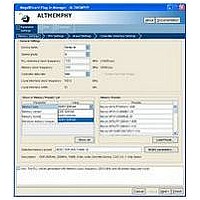IPR-HPMCII Altera, IPR-HPMCII Datasheet - Page 161

IPR-HPMCII
Manufacturer Part Number
IPR-HPMCII
Description
IP CORE Renewal Of IP-HPMCII
Manufacturer
Altera
Datasheet
1.IP-HPMCII.pdf
(176 pages)
Specifications of IPR-HPMCII
Software Application
IP CORE, Memory Controllers, SDRAM
Supported Families
Arria II GX, HardCopy III, Stratix III, Stratix IV
Core Architecture
FPGA
Core Sub-architecture
Arria, HardCopy, Stratix
Rohs Compliant
NA
Lead Free Status / RoHS Status
na
- Current page: 161 of 176
- Download datasheet (4Mb)
Chapter 9: Timing Diagrams
DDR3 High-Performance Controllers II
December 2010 Altera Corporation
The following sequence corresponds with the numbered items in
1. The user logic requests the first read by asserting the local_read_req signal, and
2. The user logic initiates a second read to a different memory column within the
3. The controller issues the first read memory command and address signals to the
4. The controller asserts the afi_doing_rd signal to indicate to the ALTMEMPHY
5. The ALTMEMPHY megafunction issues the first read command to the memory
6. The ALTMEMPHY megafunction returns the first data read to the controller after
7. The controller returns the first read data to the user by asserting the
the size and address for this read. In this example, the request is a burst of length
of 2 to the local address 0×000000. This local address is mapped to the following
memory address in half-rate mode:
mem_row_address = 0×000000
mem_col_address = 0×0000
mem_bank_address = 0×00
same row. The request for the second write is a burst length of 2. In this example,
the user logic continues to accept commands until the command queue is full.
When the command queue is full, the controller deasserts the local_ready signal.
The starting local address 0x000002 is mapped to the following memory address in
half-rate mode:
mem_row_address = 0×0000
mem_col_address = 0×0002<<2 = 0×0008
mem_bank_address = 0×00
ALTMEMPHY megafunction for it to send to the memory device.
megafunction the number of clock cycles of read data it must expect for the first
read. The ALTMEMPHY megafunction uses the afi_doing_rd signal to enable its
capture registers for the expected duration of memory burst.
and captures the read data from the memory.
resynchronizing the data to the phy_clk domain, by asserting the
afi_rdata_valid signal when there is valid read data on the afi_rdata bus.
local_rdata_valid signal when there is valid read data on the local_rdata bus. If
the ECC logic is disabled, there is no delay between the afi_rdata and the
local_rdata buses. If there is ECC logic in the controller, there is one or three clock
cycles of delay between the afi_rdata and local_rdata buses.
Section II. DDR3 SDRAM Controller with ALTMEMPHY IP User Guide
External Memory Interface Handbook Volume 3
Figure
9–8:
9–15
Related parts for IPR-HPMCII
Image
Part Number
Description
Manufacturer
Datasheet
Request
R

Part Number:
Description:
IP NIOS II MEGACORE RENEW
Manufacturer:
Altera
Datasheet:

Part Number:
Description:
IP CORE Renewal Of IP-XAUIPCS
Manufacturer:
Altera
Datasheet:

Part Number:
Description:
IP CORE Renewal Of IP-10GETHERNET
Manufacturer:
Altera
Datasheet:

Part Number:
Description:
IP CORE Renewal Of IP-ASI
Manufacturer:
Altera
Datasheet:

Part Number:
Description:
IP CORE Renewal Of IP-CIC
Manufacturer:
Altera
Datasheet:

Part Number:
Description:
IP CORE Renewal Of IP-CRC
Manufacturer:
Altera
Datasheet:

Part Number:
Description:
IP CORE Renewal Of IP-ED8B10B
Manufacturer:
Altera
Datasheet:

Part Number:
Description:
CPLD, EP610 Family, ECMOS Process, 300 Gates, 16 Macro Cells, 16 Reg., 16 User I/Os, 5V Supply, 35 Speed Grade, 24DIP
Manufacturer:
Altera Corporation
Datasheet:

Part Number:
Description:
CPLD, EP610 Family, ECMOS Process, 300 Gates, 16 Macro Cells, 16 Reg., 16 User I/Os, 5V Supply, 15 Speed Grade, 24DIP
Manufacturer:
Altera Corporation
Datasheet:

Part Number:
Description:
Manufacturer:
Altera Corporation
Datasheet:










